
Concept explainers
(a)
Interpretation:
The complete, detailed mechanism for the reaction is to be provided. The stereochemistry of the products is to be predicted where appropriate. If the reaction yields exclusively one product or a mixture of products, then the major product is to be determined.
Concept introduction:
For the prediction of the outcome of the
Answer to Problem 9.64P
The complete, detailed mechanism for the reaction is shown below:

Explanation of Solution
The given reaction is
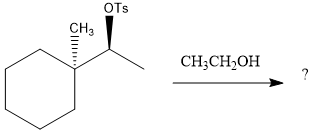
The absolute configuration of the substrate is S. This is solvolysis reaction because ethanol acts as a nucleophile and a solvent. The leaving group,
The attacking species
The loss of the leaving group,

A tertiary carbocation is highest stability than a secondary and primary carbocation. Next,

Now, the weak nucleophile,
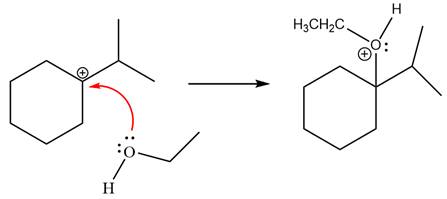
Finally, deprotonation of the
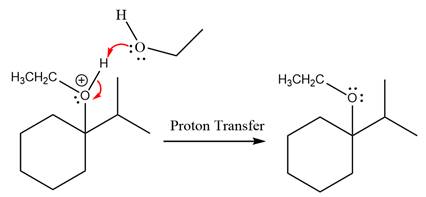
The detailed, complete mechanism is as follows:

The outcome of the given reaction is predicted by considering factors like the nature of the leaving group, substrate, the strength of the reagent used, solvent, and temperature.
(b)
Interpretation:
The complete, detailed mechanism for the reaction is to be provided. The stereochemistry of the products is to be predicted where appropriate. If the reaction yields exclusively one product or a mixture of products, then the major product is to be determined.
Concept introduction:
For the prediction of the outcome of the
Answer to Problem 9.64P
The complete, detailed mechanism for the reaction is shown below:
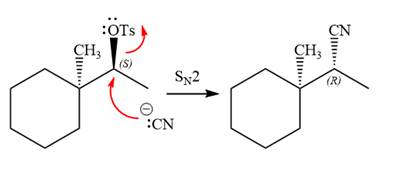
The stereochemistry of the product is R configuration.
Explanation of Solution
The given reaction is
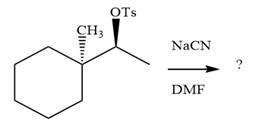
The absolute configuration of the substrate is S. The leaving group,
The attacking species
The carbon atom attached to the leaving group is a chiral center.
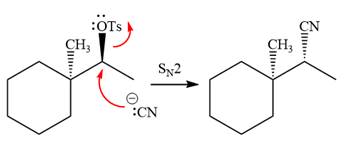
The stereochemistry of the product is R configuration.
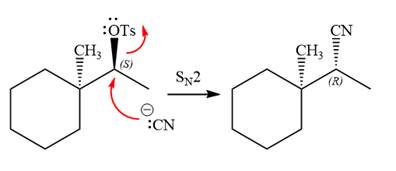
The outcome of the given reaction is predicted by considering factors like the nature of the leaving group, substrate, the strength of the reagent used, solvent, and temperature.
(c)
Interpretation:
The complete, detailed mechanism for the reaction is to be provided. The stereochemistry of the products is to be predicted where appropriate. If the reaction yields exclusively one product or a mixture of products, then the major product is to be determined.
Concept introduction:
For the prediction of the outcome of the
Answer to Problem 9.64P
The complete, detailed mechanism for the reaction is shown below:

Explanation of Solution
The given reaction is
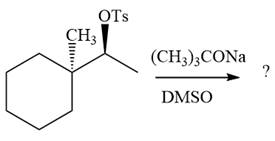
The absolute configuration of the substrate is S. The leaving group,
The attacking species
In the substrate, the alpha C atom has one H atom attached to it. Since

The outcome of the given reaction is predicted by considering factors like the nature of the leaving group, substrate, the strength of the reagent used, solvent, and temperature.
(d)
Interpretation:
The complete, detailed mechanism for the reaction is to be provided. The stereochemistry of the products is to be predicted where appropriate. If the reaction yields exclusively one product or a mixture of products, then the major product is to be determined.
Concept introduction:
For the prediction of the outcome of the
Answer to Problem 9.64P
The complete, detailed mechanism for the reaction is shown below:

Explanation of Solution
The given reaction is
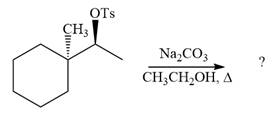
The absolute configuration of the substrate is S. The leaving group,
The attacking species
The loss of the leaving group,

A tertiary carbocation is greatest stability than a secondary and primary carbocation. Next,

Now, the weak nucleophile
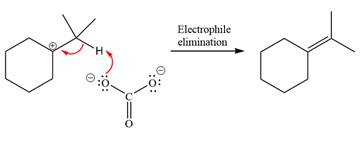
The detailed, complete mechanism is as follows:

The outcome of the given reaction is predicted by considering factors like the nature of the leaving group, substrate, the strength of the reagent used, solvent, and temperature.
(e)
Interpretation:
The complete, detailed mechanism for the reaction is to be provided. The stereochemistry of the products is to be predicted where appropriate. If the reaction yields exclusively one product or a mixture of products, then the major product is to be determined.
Concept introduction:
For the prediction of the outcome of the
Answer to Problem 9.64P
The complete, detailed mechanism for the reaction is shown below:

Explanation of Solution
The given reaction is

This is a solvolysis reaction because ethanol acts as a nucleophile and the solvent. The leaving group,
The attacking species
The loss of the leaving group,

Now, the weak nucleophile

The detailed, complete mechanism is as follows:

The outcome of the given reaction is predicted by considering factors like the nature of the leaving group, substrate, the strength of the reagent used, solvent, and temperature.
(f)
Interpretation:
The complete, detailed mechanism for the reaction is to be provided. The stereochemistry of the products is to be predicted where appropriate. If the reaction yields exclusively one product or a mixture of products, then the major product is to be determined.
Concept introduction:
For the prediction of the outcome of the
Answer to Problem 9.64P
The complete, detailed mechanism for the reaction is shown below:

Explanation of Solution
The given reaction is
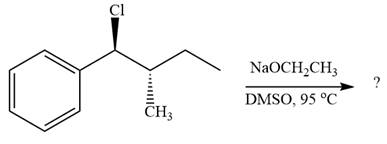
The leaving group,
The attacking species
In the substrate, only one H atom can be eliminated. The leaving group and H atom are on same side.

The base deprotonates a hydrogen atom from the substrate and to yield the most substituted alkene as the product.
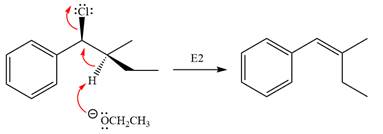
The detailed, complete mechanism is as follows:

The outcome of the given reaction is predicted by considering factors like the nature of the leaving group, substrate, the strength of the reagent used, solvent, and temperature.
Want to see more full solutions like this?
Chapter 9 Solutions
Organic Chemistry: Principles And Mechanisms (second Edition)
- PLEASE READ!!! I DONT WANT EXAMPLES, I DONT WANT WORDS OR PARAGRAPHS!!! PLEASE I UNDERSTAND THE BASICS BUT THIS IS AN EXCEPTION THAT EVEN THE INTERNET CANT HELP!!!! THIS IS THE THIRD TIME I'VE SENT THOSE QUESTIONS SO PLEASE DONT RESEND THE SAME STUFF, ITS NOT HELPING ME!!! I ALSO ALREADY TRIED TO DRAW THE MECHANISM MYSELF, SO IF ITS RIGHT PLEASE TELL ME OR TELL ME WHAT I HAVE TO CHANGE!!! First image: I have to SHOW (DRAWING) the mechanism (with arows and structures of molecules) NOT WORDS PLEASE! of the reaction at the bottom. Also I have to show by mecanism why the reaction wouldn't work if the alcohol was primary Second image: I have to show the mechanism (IMAGE) (with arrows and structures of the molecules) NOT WORDS PLEASE !! for the reaction on the left, where the alcohol A is added fast in one portion HOMEWORK, NOT EXAM!! ALL DETAILS ARE IN THE IMAGES PLEASE LOOK AT THE IMAGES, DONT LOOK AT THE AI GENERATED TEXT!!!arrow_forwardWrite the molecular formula for a compound with the possible elements C, H, N and O that exhibits a molecular ion at M+ = 85.0899. Exact Masses of the Most Abundant Isotope of Selected Elements Isotope Natural abundance (%) Exact mass 1H 99.985 1.008 12C 98.90 12.000 14N 99.63 14.003 160 99.76 15.995 Molecular formula (In the order CHNO, with no subscripts)arrow_forwardUse the data below from an electron impact mass spectrum of a pure compound to deduce its structure. Draw your structure in the drawing window. Data selected from the NIST WebBook, https://webbook.nist.gov/chemistry/ m/z Relative intensity 59 3.0 58 64 43 100 15 23 • You do not have to consider stereochemistry. •You do not have to explicitly draw H atoms. • In cases where there is more than one answer, just draw one. + n[] 85 // ? CH4 Previous Nextarrow_forward
- Write the molecular formula for a compound with the possible elements C, H, N and O that exhibits a molecular ion at M* = 128.0632. Exact Masses of the Most Abundant Isotope of Selected Elements Isotope Natural abundance (%) Exact mass 1H 99.985 12C 98.90 14N 99.63 160 99.76 Molecular formula 1.008 12.000 14.003 15.995 (In the order CHNO, with no subscripts)arrow_forwardCan I please get help with this? And can I please the lowest possible significant number?arrow_forwardWhat is the molar mass of a gas that takes three times longer to effuse than helium?arrow_forward
- First image: I have to show the mecanism (with arows and structures) of the reaction at the bottom. Also I have to show by mecanism why the reaction wouldn't work if the alcohol was primary Second image: I have to show the mecanism (with arrows and structures) for the reaction on the left, where the alcohol A is added fast in one portion its not an examarrow_forwardwhat is the skeletal structure of a tertiary alkyl fluoride with six carbon atoms and no rings.arrow_forwardOne step of glycolysis is a retro-aldol reaction (aldolase) to produce ATP.Below is the aldol reaction of the equilibrium. Show the mechanism for the base catalyzed reaction. *see imagearrow_forward
 Organic Chemistry: A Guided InquiryChemistryISBN:9780618974122Author:Andrei StraumanisPublisher:Cengage Learning
Organic Chemistry: A Guided InquiryChemistryISBN:9780618974122Author:Andrei StraumanisPublisher:Cengage Learning

